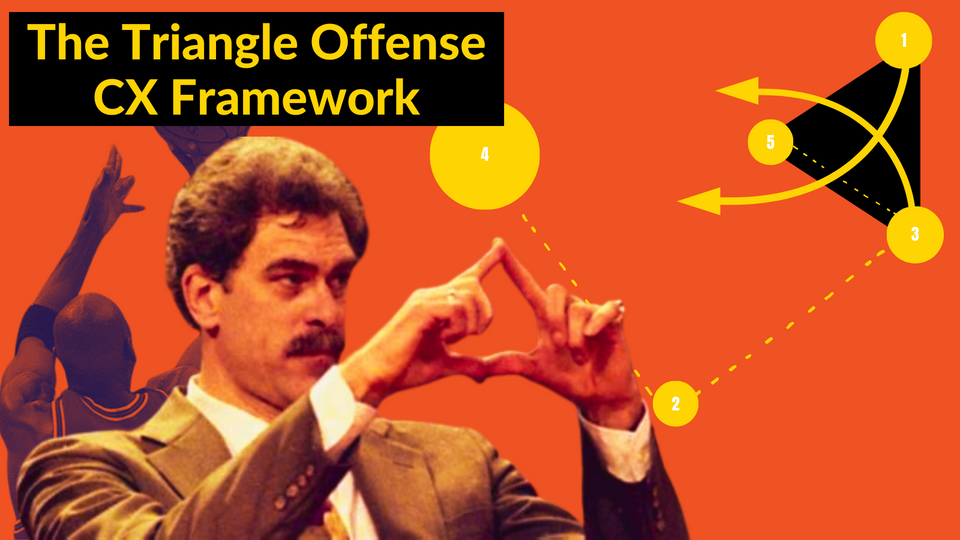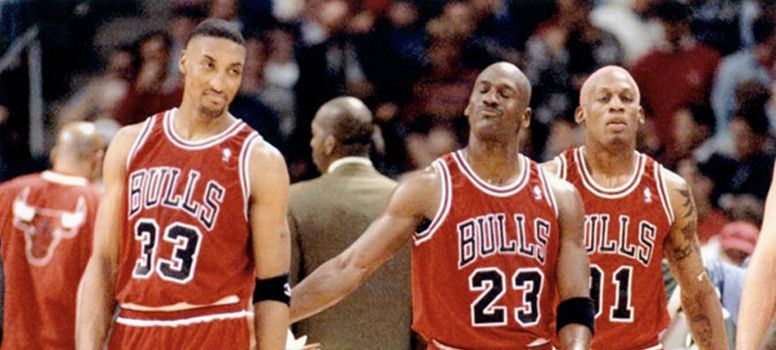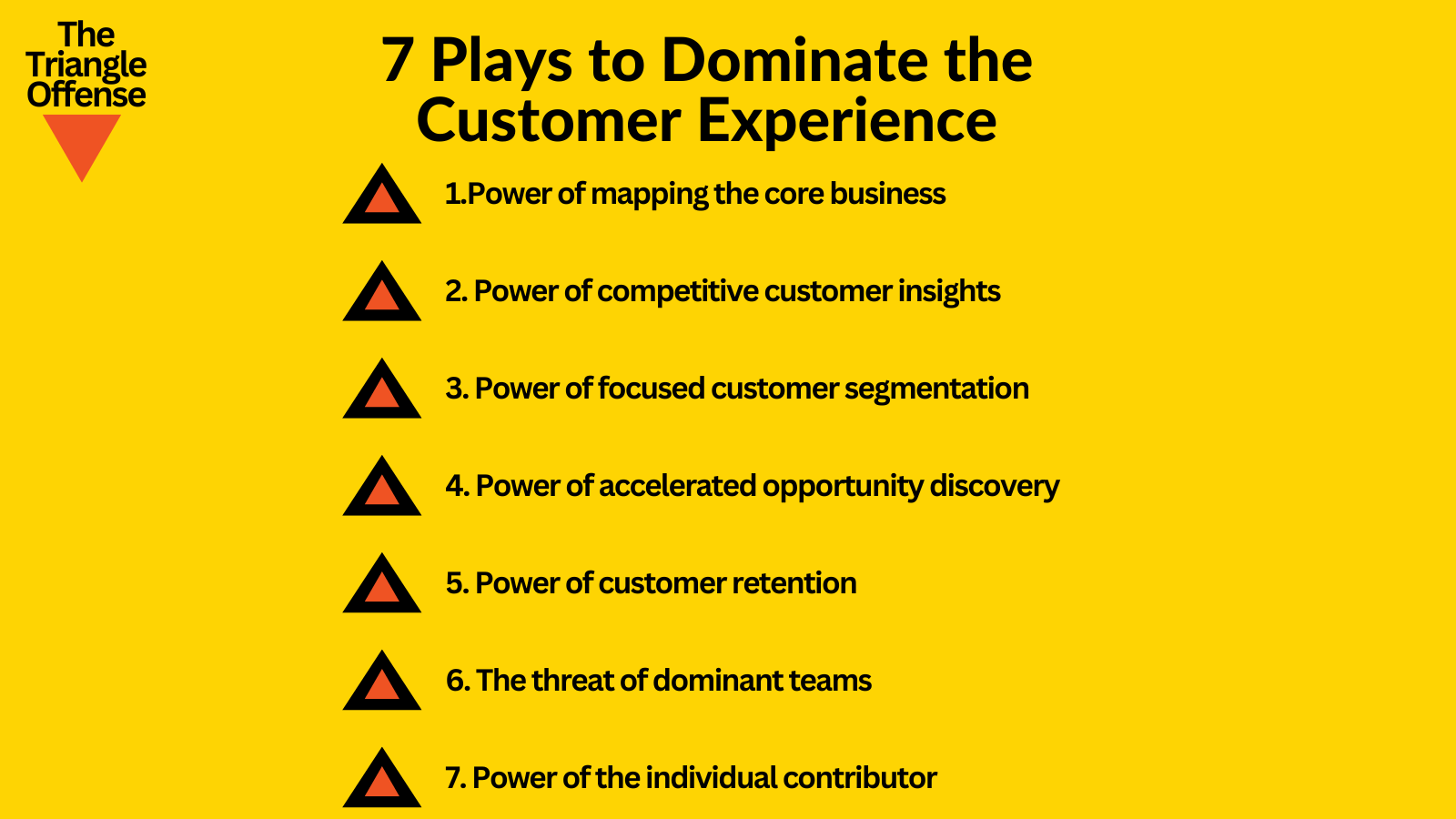What is The Triangle Offense CX Framework?
Looking to enhance your business's customer experience? The Triangle Offense CX Framework helps you increase revenue and dominate your market through targeted customer experience improvements.

A CX Framework that Increases Your CX Strategy’s ROI
The Triangle Offense is a customer experience (CX) framework and management tool for business leaders. It helps them find opportunities to improve their customer experience, drive customer satisfaction, identify CX investments that help sustain the business's competitive advantage, and increase meaningful ROI.
Discover how the Chicago Bulls inspired the Triangle Offense framework.

Triangle Offense: Seven Power Plays to Dominate the Customer Experience and Win

The seven Triangle Offense power plays are:
- Mapping the core business
- Competitive customer insights
- Focused customer segmentation
- Accelerated opportunity discovery
- Customer retention
- Curbing dominant teams
- The individual contributor
1. Mapping the Core Business
This play examines your core business model’s end-to-end customer journey and seeks to identify areas that need immediate improvement.
This play’s objective is to create a customer journey map by:
- Pinpointing the key moments in the customers’ journey where your business is not meeting their expectations and needs.
- Sharing key moments of the journey that your entire organization understands.
- Forming the foundation of your voice-of-customer (VOC) data-gathering process.
Businesses might run this play when they want to:
- Increase customer satisfaction by improving the general customer experience.
- Reduce churn and retain more loyal customers.
- Improve the omnichannel customer experience.
- Understand the revenue attribution of the touchpoints in the customer journey map and how it affects revenue generation.
2. Competitive Customer Insights
This play evaluates your business’s voice of the customer (VOC) data-gathering process. When a company serves a specific customer segment and thereby creates an associated customer experience, they must streamline the VOC data-gathering process to quickly identify unmet customer needs and invest in a solution.
But when a business sells to multiple customer segments, gathering the necessary customer insights to sustain a competitive advantage in your industry becomes harder. Streamlining the VOC data-gathering process when multiple customer segments overlap is perhaps even more critical for your business.
This play aims to provide your business with a functioning qualitative customer data pipeline you can use to identify new opportunities to improve the customer experience across multiple customer segments.
Businesses might run this play when they want to:
- Build a VOC qualitative data-gathering process foundation.
- Combine qualitative data with operations processes to improve the customer experience.
- Connect qualitative data with broader organizational data such as CRM systems, transactional data, and customer surveys.
3. Focused Customer Segmentation
This play emphasizes the importance of focused specific customer segment research to capture new revenue. When you understand your target customer segment's unique needs and preferences, you can tailor a product or service to the customers’ needs that will give you a competitive edge.
This play aims to help your business expand into a new customer segment by leveraging customer research to generate new revenue. Then you can make multiple CX investments that act as scouting or positioning options and test whether your product or service meets that new customer segment’s needs. When you’ve met these needs successfully, you’ll be able to establish a foothold in the new segment.
Businesses might run this play when they want to:
- Immediately begin expanding into a new customer segment to generate new revenue.
- Understand how to start creating the prospective segment’s customer experience.
4. Accelerated Opportunity Discovery
This play assists a business when it invests in a complex customer experience opportunity that needs rapid implementation to gain a timely competitive advantage over its industry peers.
It aims to mitigate a CX opportunity’s risk when that opportunity requires a significant financial investment, as the business team will want to know how to match customers’ needs before they invest a large sum of money. Running this play ensures you build your product or service much faster than your competitors, utilize the latest rapid-discovery methods, and minimize the risk of not meeting the customers’ needs and desires.
Businesses might run this play when they want to:
- Derisk the opportunity to build or sell a new product or service that requires a substantial monetary commitment.
- Deliver an improved and differentiated customer experience before their competitors can do it.
- Execute a group of connected CX omnichannel improvements that require coordinated discovery.
5. Customer Retention
This play identifies a business's most valuable customer (MVC) segment through CLV, ARR, and customer insight research. It then asks, “What can we do to retain them as customers?” Your business survival depends on customer retention and the power of their repeated purchases.
"Increasing customer retention rates by 5% increases profits by 25% to 95%." - Frederick F. Reichheld (Source)
This play aims to utilize MVC insights to improve the overall customer experience and increase customer retention. Numerous studies have shown that increased customer retention can lead to a significant profit expansion.
Businesses might run this play when they want to:
- Gather insights about the MVC segment to ensure retention.
- Reduce customer churn, improve the customer experience, and thereby increase customer retention.
6. Curbing Dominant Teams
This play examines a business’s organizational design and how it manages to improve the customer experience. Are the teams that make decisions about improved customer experience opportunities weighted equally? Or is a dominant team making the majority of the decisions, leaving very little room at the table for the other teams?
"Michael, if you can't pass, you can't play." - Coach Dean Smith to Michael Jordan in his freshman year at UNC
This play aims to improve organizational design, so all teams, including the general business team, product team, and GTM team, have a voice in improving the customer experience from their perspective.
Businesses might run this play when they want to:
- Address organizational gaps in customer experience management.
- Understand how to re-organize their teams to execute the CX strategy more effectively.
- Assess the impact of a reduction in force (RIF) on customer experience management.
7. The Individual Contributor
This play analyzes a business’s organizational design and how individual contributors (ICs) are utilized to manage and improve the customer experience. The IC (a CX practitioner) must be placed to successfully manage key moments of the customer journey to ensure the experience has no gaps.
When a key moment in the customer experience fails to meet the customer's expectations, the IC must be positioned to act quickly, repair the affected key moment, and restore the customer's trust in your business.
This play aims to ensure that your ICs are well-positioned and have the authority to manage the customer experience. ICs must be nurtured and coached to develop into powerful CX advocates who close the customer/business gap.
Businesses might run this play when they want to:
- Position ICs to manage key moments in a customer journey and create single-threaded ownership.
- Nurture and develop ICs to become CX practitioners who combine business with functional expertise to manage the customer experience.
Summary
Business leaders wholeheartedly agree that customers and their experiences should be the top priorities for their business. Simply put, a business wouldn't exist without customers spending their hard-earned money on the company’s products and/or services. The Triangle Offense CX Framework helps business owners and leaders run CX plays to improve the customer experience and retain their customers’ loyalty, thereby driving more revenue to the company.
The Triangle Offense framework’s seven power plays focus on timeless problems that businesses encounter as they look for ways to generate revenue by meeting their customers’ needs. Everything starts and ends with the customer because somewhere in America, a competitor is eyeing your industry and will exploit the gaps in your customer experience to lure customers to their business.
The Triangle Offense CX framework is there to help guide your business so it survives and outlasts your competitors.
Written by Leo Vroegindewey, B2B CX Consultant
Get in touch to improve your customer experience and increase sales. Let's talk about how I can help your business grow. Email me.
You can find me on X or LinkedIn.
